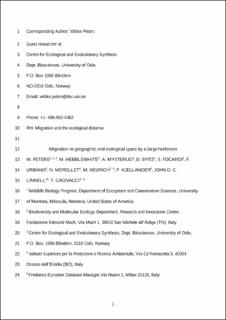Migration in geographic and ecological space by a large herbivore
Peters, Wibke Erika Brigitta; Hebblewhite, Mark; Mysterud, Atle; Spitz, Derek; Focardi, Stefano; Urbano, Ferdinando; Morellet, Nicolas; Heurich, Marco; Kjellander, Petter; Linnell, John Durrus; Cagnacci, Francesca
Peer reviewed, Journal article
Accepted version

View/
Date
2017Metadata
Show full item recordCollections
- Publikasjoner fra CRIStin - NINA [2397]
- Scientific publications [1423]
Abstract
Partial migration, when only part of the population migrates seasonally while the other part remains resident on the shared range, is the most common form of migration in ungulates. Migration is often defined by spatial separation of seasonal ranges and consequently, classification of individuals as migrants or residents is usually only based on geographic criteria. However, the underlying mechanism for migration is hypothesized to be movement in response to spatiotemporal resource variability and thus, migrants are assumed to travel an “ecological distance” (ED) or shift their realized ecological niches. While ecological and geographic distances should be related, their relationship may depend on landscape heterogeneity. Here, we tested the utility of ecological niche theory to both classify migratory individuals and to understand the underlying ecological factors for migratory behavior. We developed an integrative approach combining measures in geographic and ecological niche space and used this to classify and explain migratory behavior of 71 annual roe deer (Capreolus capreolus) movement trajectories in five European study areas. First, to assess the utility of the ED concept for classifying migratory behavior, we tested whether roe deer sought the same ecological conditions year-round or moved to different ecological conditions by measuring the annual ED travelled and the seasonal niche overlap using multivariate statistics. Comparing methods to classify migrants and residents based on geographic and ecological niche space, we found that migratory roe deer switched between seasons both in geographic and in ecological dimensions. Second, we tested which seasonal ecological factors separated resident from migrant niches using discriminant analysis and which broad-scale determinants (e.g., spatiotemporal forage variation and population density) predicted migration probability using generalized linear models. Our results indicated that factors describing forage and topographic variability discriminated seasonal migrant from resident niches. Determinants for predicting migration probability included the temporal variation (seasonality) and also the spatial variability of forage patches. Last, we also found suggestive evidence for a positive relationship between population density and migration probability. By applying the ecological niche concept to the study of partial migration in ungulates, our work underlines that partial migration is a form of behavioral plasticity. Key words: behavioral plasticity; Capreolus capreolus; ecological distance; large herbivores; niche switching; Normalized Difference Vegetation Index; partial migration; realized niche; spatiotemporal variation; ungulates